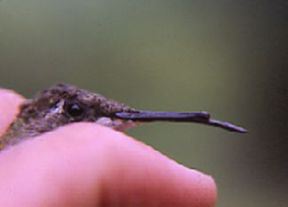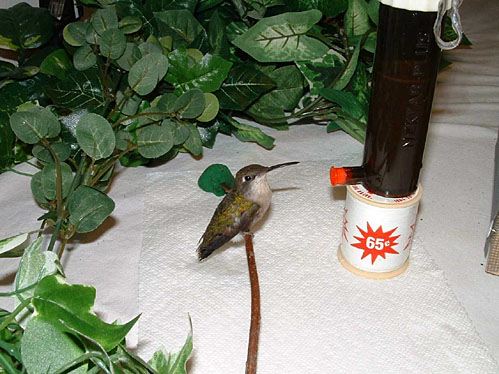|
home: www.rubythroat.org |
|
|
home: www.rubythroat.org |
|
| As with other wild animals, life is full of danger for hummingbirds, whether from weather, predators, disease or human intervention. The front third of the upper bill of this female Ruby-throated Hummingbird (Archilochus colubris) was missing when she was captured, perhaps the result of flying into something. The broken spot was swollen and the lower bill was misshapen, indicating that it was an old injury that was healing while still allowing the bird to survive. |
 All text & photos © Bill Hilton Jr. |
|
© Bill Hilton Jr. |
A stunned Ruby-throated Hummingbird (Archilochus colubris) often may be rejuvenated by giving it a drink of sugar water. Grasp the bird gently as illustrated and slide its bill in and out of the feeder port several times. If it drinks, try to release it; if it still will not fly, place it in a dark box and contact a local wildlife rehabilitator for instructions. |
-- If the bird still will not fly, put a soft, smooth cloth (e.g., a dishtowel--but NOT terrycloth in which the bird may tangle its claws) in the bottom of a shoe box or similar container with loose-fitting lid that will be dark when closed and place the hummingbird on the cloth.
-- Close the box and call your local wildlife rehabilitator for further instructions; a list of rehabilitators in the United States, Canada, and some other countries is at http://wildliferehabinfo.org . If you have difficulty finding a rehabber, call your local veterinarian, keeping in mind that many vets are not trained to deal with birds, wild or otherwise.
-- You can also contact Operation RubyThroat via QUESTIONS. However, an injured hummingbird probably needs immediate attention and because we sometimes are away from Hilton Pond Center for Piedmont Natural History you may not receive an e-mail response for a day or two.
-- Hummingbirds need to eat frequently, so if your injured bird is taking food it should be fed several times each hour; this is a heavy responsibility for a caretaker.
-- Sugar water is insufficient as a long-term diet for hummingbirds; the mix only provides carbohydrates and they need fats and proteins that normally come from tiny insects. You can try crushing up fruit flies (they're those little flies that buzz around ripe bananas) and adding them to the sugar water, but it is better to purchase Nektar-Plus, a water-soluble balanced hummingbird formula, from a local veterinarian who specializes in bird care. You can order this product from Squirrel Store, but because of shipping time it may arrive too late to be of use to your injured hummingbird.
-- NOTE #1: Remember that it is against federal, state, or provincial laws in the United States, Canada, and some other countries to keep a hummingbird in captivity without special permits.
-- NOTE #2: It may seem dispassionate, but remember that not all hummingbirds survive; up to three-quarters of a given year's fledglings are likely to die due to predators, disease, accident, migrational difficulties, or other problems. It is unfortunate when a hummingbird dies due to humans--as when a bird flies into a picture window or the family cat kills a hummer--so we should do our best to minimize human-induced mortality. Nonetheless, hummingbirds are extremely difficult to rehabilitate and it may be that a bird you try to help simply will not make it.
--NOTE #3: If the hummingbird you rescued was injured or killed by your cat, then YOU are to blame. Although cats make wonderful indoor pets, they have no business roaming outside where they follow their natural instincts in killing almost anything that moves. If you really love animals--including your cat--keep all felines indoors for their own well-being AND for the safety of wildlife in your neighborhood.
--NOTE #4: If your injured hummingbird dies, consider improving your local habitat by planting some hummingbird flowers in its honor. You can also make a gift in support of hummingbird research in one of the ways below.
|
Make direct donations on-line through
Network for Good: |
 |
|
LIKE TO SHOP ON-LINE?
Donate a portion of your purchase price from 500+ top on-line stores via iGive: |
|
|
Use your PayPal account
to make direct donations: |
|

A Ruby-throated Hummingbird (above) being rehabilitated by
Connie Sale of Wildlife Response Inc. of Chesapeake,
Virginia USA. While the bird's cage is being cleaned,
Connie places the bird on a perch stabilized by a ball of
clay at each end; the feeder--filled with Nektar-Plus formula--
is kept at just the right height with a 65-cent spool of thread!
Back to Hummingbird Questions & Answers
Up to Top of Page
|
|
Share Your Hummingbird Experiences Through "Hummingbird Hobnob" |
 |
Operation |
|
|